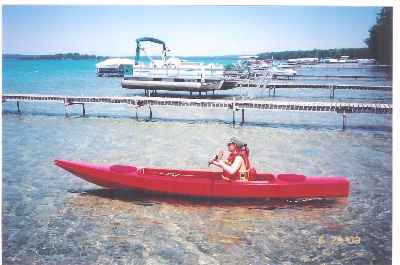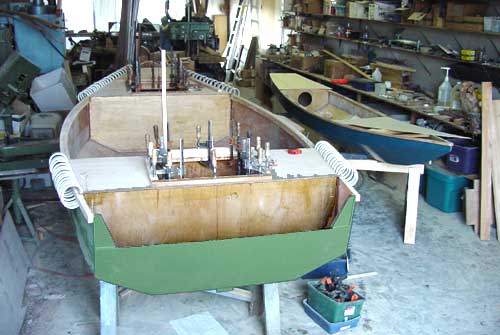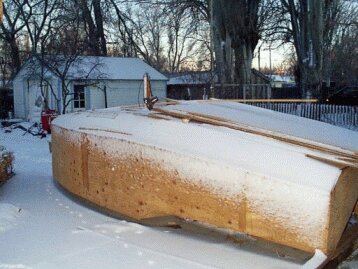
Derek Seestedt built this AF3, with a boomless lateen sail from another boat, in Michigan and cruised it on the Louisiana Gulf Coast.
Contents:
Contact info:
Jim Michalak
118 E Randall,
Lebanon, IL 62254Send $1 for info on 20 boats.
Jim Michalak's Boat Designs
118 E Randall, Lebanon, IL 62254
A page of boat designs and essays.
(1Apr04) This issue continuest an essay about figuring how much sail area your boat needs. The 15Apr04 issue will finish the topic.
THE BOOK IS OUT!
BOATBUILDING FOR BEGINNERS (AND BEYOND)
is out now, written by me and edited by Garth Battista of Breakaway Books. You might find it at your bookstore. If not check it out at the....ON LINE CATALOG OF MY PLANS...
...which can now be found at Duckworks Magazine. You order with a shopping cart set up and pay with credit cards or by Paypal. Then Duckworks sends me an email about the order and then I send the plans right from me to you.
FIGURING SAIL AREA 2
TO REVIEW...
...We are trying to calculate how much sail a boat can handle. First we want to calculate the force on the sail required to capsize the boat. We started with this picture of a sailing boat in balance:

We can write the basic balance as the sail force S = W x D / L where W x D is the "righting moment" of the hull and D is the distance between the center of the sail area and the center of the leeboard (or keel or centerboard, etc.) area. W is the total weight of the boat with everything on board. L is often called the "righting arm" and changes as the boat rolls and is fairly difficult and tedious to calculate. But the free program Hullforms can handle it. To use Hullforms one must first model the hull in three dimensions, like this one shown for the boat Picara:

Given the hull lines and a weight/center of gravity information Hullforms will calculate the value of L and graph it for various values of heel as when the hull rolls. Here is the graph for Picara at 2000 pounds weight and with the cg 24" off the bottom:

Here Hullforms is calling the righting arm "Gz" instead of "L". The maximum value is .84' so the maximum righting moment of Picara would be 2000 x .84 = 1680 ft-lb.
Here is a picture of Picara's sail rig:

The distance between the sail area center and the leeboard center is about 13'. So if we solve for the maximum allowable sail force we would get S = 1680 / 13 = 129 pounds. If the force on the sail exceeds that amount then Picara will roll past the point of maximum righting moment (at 24 degrees heel according to Hullforms) and continue to roll until the force on the sail is relieved.
FORCE ON A SAIL...
Now the idea is to relate that sail force to real life conditions.
I'm not sure who first figured out how to calculate the force on an object in a given wind but no doubt it goes back to about 1900 when folks started taking a scientific look at flying. Indeed many really old text books will include wind tunnel tests on sails! No doubt really detailed testing has been done by modern racers but most of the numbers I remember were seen in writings by Tony Marchez.
Essentially the force of the wind on an object at sea level is of the equation:
F = .0034 x A x C x V x V.
" A" is full sail area in square feet.
The coefficient "C" is the subject of much debate. The value of C varies with "angle of attack" which is the angle the wind acts upon the sail as shown below. But it tends to peak at about 1.5 for most good sails. Really super sails might peak at something like C=2.0 and a clunker might be down around 1.0, but when running downwind all sails will have a C of about 1.2. C = 1.5 is actually a fairly high value and few aircraft wings can operate at such a high value in real life without resorting to articulated flaps or leading edge slots.
. 
As you see, the force on the sail increases proportionally with the angle of attack until it peaks and then decreases until the force on the sail is all drag and the coefficient is about 1.2. Tall skinny sails can reach their maximum at much lower angles than short fat sails. They can also be more efficient at low angles of attack because they have less drag and thus can provide better performance sailing into the wind (but they are harder to control that short sails so the effect may not be always real). Often tall narrow sails are less effective on other points of sail. Still, the peak value of C is little effected by the aspect ratio of the sail.
On rigs with several sails, the sail closest to the bow is often the most efficient since it gets the smoothest air. A large well shaped jib sail operating in front of a narrow main sail can be operating at a coefficient of more than 2 since the little main is working now like a trailing edge flap on an aircraft wing. The main sail will be operating at a much lower coefficient so the total might be close to 1.5. A mizzen is blanketed by those big sails up front and probably never operates at a C of 1.5.
The "V" in the equation is wind speed in knots. Since this value is multiplied twice, "squared", its effect can quickly overwhelm other factors. For example a 15 knot wind will produce 2.25 times as much sail force as a 10 knot wind. A 20 knot wind will produce 4 times as much force as a 10 knot wind. You can see that sailing in gusting winds can be a challenge. Design your boat for all out best in 10 knot winds and she will be grossly overpowered in a 20 knot gust. That's why nimble athletes make good dinghy racers and sometimes the heavier they are the better.
YSail area can be viewed as a somewhat arbitrary thing as a result of extremes in pressure resulting from fickle winds. One designer might give a skiff 100 square feet of sail and the next give it 50 and both claim they've got it right. The first might have it right in 8 knots wind and the second in 12 knots wind.
Anyway, the pressure on the sail can easily be calculated and charted out like this:

I've shown three value of C in the chart but remember that most good ones will be in the 1.5 area.
WE'RE GETTING CLOSER....
So you have another unknown in this matter, how fast will the wind blow? My feeling is that the sail should be sized such that you will need to shorten sail (tie in a reef) at about 14 knots. Why that number? Two reasons. First is that where I live a 14 knot wind will be kicking up whitecaps, a visual indication that you need to reef. Yes, it is arbitrary. Second is that the 14 knot wind produces about 1 psf on a typical good sail, a number I usually can remember.
How would this apply to the Picara example? Remember that the force on the sail required to knock down the boat is 129 pounds. So the sail area required to produce that force in a 14 knot wind is 129 square feet. In reality Picara has 171 square feet total of which 33 is in the mizzen. You might argue that the mizzen area is not as effective and the 138 square foot main is about right on. But I know the mizzen area can capsize a boat given the right conditions (as proven to me directly a long time ago when I capsized my Bolger Jinni).
Let's look at it a different way. How much wind is needed to knock down Picara in the given weight/cg condition? If you say the full sail area is effective then the wind pressure needed to capsize the boat is 129/171 = .75 psf and that occurs at about 12 knots of wind. Can you tell the difference between a 12 knots and 14 knots of wind without a measuring device? I can't. To me aerodynamics is not such an exact science that you can predict what a craft will do in real life until you build it and try it. I'm reminded of my term in the missile factory when it was planned to add four studs, about as big as your thumb, to the exterior of a missile that was about the size of an automobile in order to better support it in its launch tube. The aero engineers went through the roof with chart after chart of why it would reduce range below the minimun. But they test flew one and the studs increased the range! And then the aero guys said, "Of course! The studs acted like vortex generators that engergized the boundary layer, etc., etc., etc.". And they had plenty of charts to prove that too. They had charts to prove anything. We all did.
NEXT TIME...
We'll juggle these numbers one last time with more examples.
TOTO
TOTO, DOUBLE PADDLE CANOE, 13' X 30", 45 POUNDS EMPTY

The photo above is from Tom Raidna.
Toto has been my most successful design. Initially she was an experiment to test a new bow shape - a deep V bow that blends into a multichine well aft. There's a twist in the bow bilge panels and at the time I didn't know how to expand those panels on the drawing board. So I built her without them and then sized them by cut and fit. Then I recorded the shapes on the prints. Nowadays this sort of twisted paned expansion is routine on a computer to great accuracy (provided the input is accurate).
The boat is an easy prefab job from two sheets of 5MM ply. Marc Smith came to the 1994 Midwest Messabout with tow of these Totos strapped to the roof of his Birdwatcher. They were built by two twelve year old girls under Marc's guidance. Marc said the girls did all the work including using the power tools. And they paddled around the Messabout in them.
It's fun to compare Toto with the typical minimal dink because they usually come from the same pile of stuff and labor. Toto covered the 6000 foot long dam at Carlyle lake in 14 minutes with a moderate paddling effort for 4-1/2 mph. She's more seaworthy but she's wetter when pressed because of paddle splash. She has a buoyancy/storage chamber aft. It will keep your shoes and stuff dry while you splash around and I believe it has about 180 pounds of buoyancy volume if the hatch cover stays watertight. (But you can't "self rescue" in any boat like this without very special training. It's best to stay within a short swim or wade to shallow water.) The open cockpit is large enough to allow sleeping inside, as I have done many times. She's shaped for easy cartopping. In good conditions she'll paddle two adults. The long lean bow seems to ignore an overload, unlike plumb bows which can become cranky when immersed. She'll take you through some very rough stuff if you are solo. But the dinks have their place too. They can have sailing stability and many will find their elevated seating more comfortable. By the way, a boat like Piragua with a simple wide flat bottom won't be as fast or as seaworthy as Toto, but you might be able to stand up in Piragua. Don't expect to do that in a boat like Toto.
I've rounded up some more Toto photos. Here are three by John Mulligan on Long Island. These three and Raidna's look to me to be build per blueprint. (I'd sit a little farther forward myself.)

Dale Dagger rides a wave in Nicaragua in his Toto.

Here is Bob Hoffert's Toto in Ohio, maybe the first boat after mine. Looks like he has added a fore deck and put a big access hole in the aft bulkhead. (Remember that the aft storage box is also supposed to be an emergency buoyancy air box to help save your butt in a capsize.)

Here is John Ellwood's Toto in Massachusetts. Crowned fore and aft decks and another access hole in the aft bulkhead, although this one appears to have a cover.

Here is Garth Battista of Breakaway Books with a small foredeck and some good company:

Here is Don Duquet with good company getting ready to watch a space shuttle launch:

Here is Bob Cole's delux Toto, totally decked with watertight storage in both ends way up in northern Canada:

And the fanciest Toto ever by Dean Souza in Washington, with watertight storage fore and aft, fancy coamings, cleats and line chocks, even the national flag flying on the stern!

Bob Hoyle in Florida:

And Al Fittipaldi (New Jersey) made this Toto and got a picture of it in Woodenboat magazine!

And Amanda in Barry Johnson's Toto in South Carolina. He has a Toto construction website at Barry Builds Toto

And Bill Turnbull's Toto on the Florida gulf coast:

And Stephen Dandridge's Toto delux out in California:

And we think this is Terry Lesh's Toto delux (seen at a boat show out West):

And here is one by Don O'Hearn of St. Louis, photo from the 2002 Rend Lake Messabout:

And Al Straub's Toto in Michigan:

That is all I can find photos for right now. I'm sure there are more.
Plans come with complete instructions including the details of taped seam construction and a drawing of a simple paddle that works. (Marc Smith's girls used double paddles made from old vaulting poles with plywood blades bolted on. I tried their boats and paddles and they were quite good.) No jigs or lofting required.
Blueprints plus instructions for Toto are $15 when ordered directly from me.
Prototype News
Some of you may know that in addition to the one buck catalog which now contains 20 "done" boats, I offer another catalog of 20 unbuilt prototypes. The buck catalog has on its last page a list and brief description of the boats currently in the Catalog of Prototypes. That catalog also contains some articles that I wrote for Messing About In Boats and Boatbuilder magazines. The Catalog of Prototypes costs $3. The both together amount to 50 pages for $4, an offer you may have seen in Woodenboat ads. Payment must be in US funds. The banks here won't accept anything else. (I've got a little stash of foreign currency that I can admire but not spend.) I'm way too small for credit cards.
The Texas Ladybug is getting details (Toto in background):

Out West the Picara project gets its bottom. Winter shifts work to sailmaking indoors:

The Deep South Skat is getting its brightwork:

Another Picara, this one with a 1' stretch in the middle, going together in Arkansas. Sailmaking right now.

AN INDEX OF PAST ISSUES
Hullforms Download (archived copy)
Plyboats Demo Download (archived copy)
Brokeboats (archived copy)
Brian builds Roar2 (archived copy)
Herb builds AF3 (archived copy)
Herb builds RB42 (archived copy)